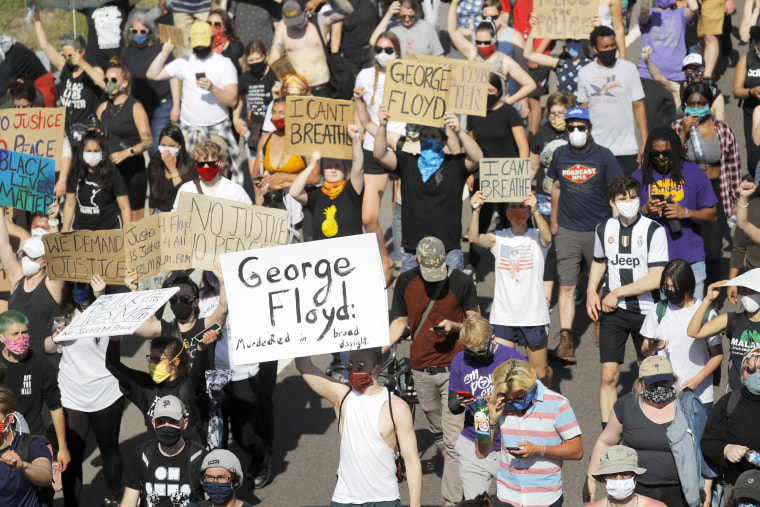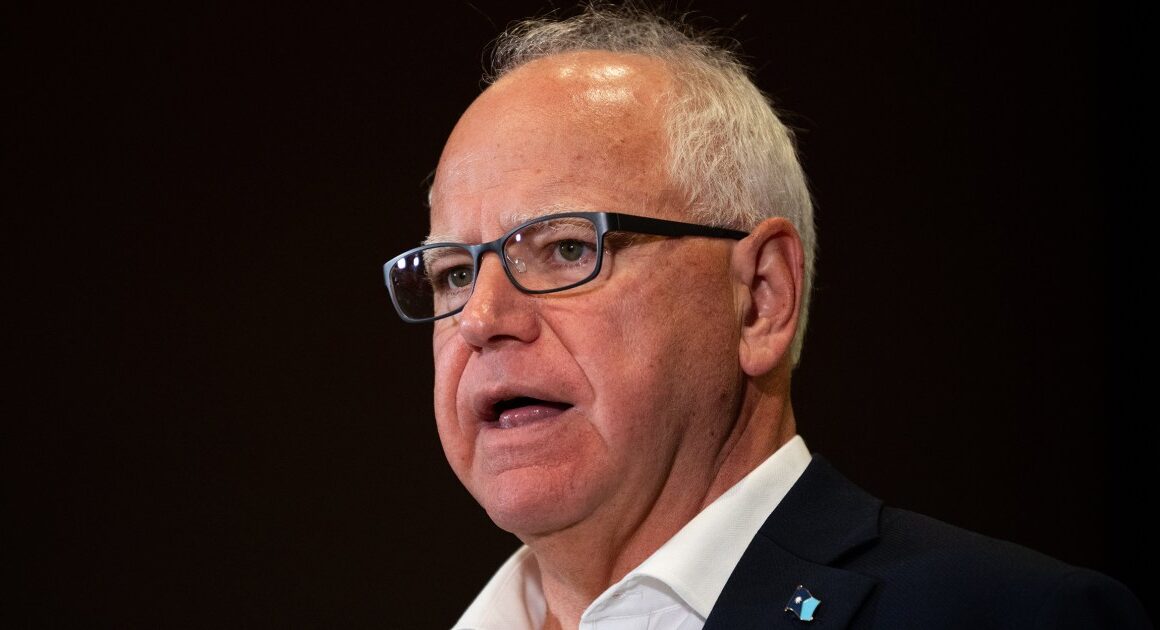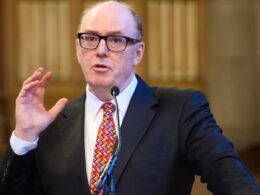Even before Vice President Kamala Harris selected Minnesota Gov. Tim Walz as her running mate Tuesday morning, Walz was facing fresh scrutiny over what critics said was a delay in calling in the National Guard during the 2020 protests that engulfed Minneapolis after the murder of George Floyd.
Republicans all the way up to former President Donald Trump have claimed Walz was responsible for that delay, criticism that quickly coalesced into one of the main arguments against the freshly formed Democratic presidential ticket Tuesday, though Trump also offered praise to Walz for his handling of the situation in 2020.
Just hours after Harris picked Walz, GOP vice presidential nominee JD Vance claimed Walz, who struck a conciliatory tone after Floyd’s murder and the violence that followed, was “cheering on” rioters in Minneapolis as it “burned” during the May 2020 protests — a criticism also quickly echoed by the Trump campaign, the Republican National Committee and the Trump-aligned MAGA Inc. super PAC.
Trump himself has also falsely claimed — including last month during a rally in St. Cloud, Minnesota — that as president it was he, not Walz, who called in the National Guard during the protest, after Walz dragged his feet. While that claim is not true, Walz and the Minneapolis mayor have long pointed fingers at each other over the delayed response, with Republicans blaming both of them in a later legislative investigation.

Criticism over a delay in responding to riots
In May 2020, in the days after a Minneapolis police officer killed Floyd, protests erupted throughout Minneapolis and St. Paul and, in short order, throughout cities across the U.S. In Minnesota, some of the protests quickly turned violent, resulting in massive burning, looting and destruction in large parts of downtown Minneapolis.
At the time, Republicans blamed Walz for not responding to the protests more quickly and more aggressively. Specifically, they pointed to what they said was a three-day delay in Walz’s ordering the National Guard into the Twin Cities to help quell the unrest. The criticisms re-emerged as Walz climbed his way up Harris’ running mate short list last week.
A report by Minnesota state Senate Republicans in October 2020 stated that Walz “had the ability and duty to use force and law enforcement to stop criminal violence, but he did not.
“Governor Walz was not willing to do what was necessary to stop the rioting right away because he was having a philosophical debate about whether the use of force should be used to stop violence,” the report’s authors wrote.
Walz’s office confirmed at the time that he, a 24-year veteran of the National Guard, activated the guard following official requests from the Democratic-led cities of St. Paul and Minneapolis. The activation in 2020 occurred before Walz spoke to the White House.
Floyd was killed on May 25, 2020, while in Minneapolis police custody. The next day — following the release of a video showing Floyd, as he died, saying he couldn’t breathe while police officer Derek Chauvin kneeled on his neck — protests kicked off throughout the city. By May 27 there were reports of vandalism, looting and arson, in addition to peaceful protests, in the city.
Minneapolis Mayor Jacob Frey has said he called Walz in the evening of May 27, shortly after he’d heard of a Target store being looted, to request that the National Guard be sent in.
“We expressed the seriousness of the situation. The urgency was clear,” Frey told the Star Tribune in August 2020. “He did not say yes,” Frey told the newspaper. “He said he would consider it.”
A Star Tribune investigation into the exchange found that Frey’s staff felt his conversation with Walz constituted a formal request that the guard be sent. Through public records requests, the newspaper discovered texts confirming that Frey had a conversation making a request to Walz — but that no confirmation came from Walz or his office that the guard was being activated on May 27.
Frey has said his office followed up on the morning of May 28 with a written request to Walz that the National Guard be deployed. St. Paul Mayor Melvin Carter sent a similar letter hours later on May 28.
Frey’s and Walz’s offices have publicly disputed what would have constituted a formal request for National Guard assistance. Walz’s office has said that a verbal request is not considered a formal request. Federal regulations are not explicit about whether the request must come in writing.
Bill George, the former CEO of Minneapolis-based health care tech giant Medtronic — and a decadeslong Minneapolis resident who said he lived 2 miles from some of the more violent protests — recalled how “the protests started out as peaceful, and then as things wore on, became very violent.” George, a Walz supporter, said he puts blame on Frey for the delayed response.
Spokespeople for Walz and Frey did not respond to NBC News questions on the subject.
Walz did not activate the Minnesota National Guard until the afternoon of May 28, when his office issued a news release announcing the move. And moments later, the Minnesota National Guard said on social media that the unit was “currently in process of” responding to the request.
Later that night, at 10:41 p.m. local time, the Minnesota National Guard posted on X that it had “activated” 500 soldiers in and around the Twin Cities.
About an hour after that, at 11:53 p.m. local time, Trump wrote on X that he would “send in the National Guard” because “I can’t stand back & watch this happen.” In a second post, Trump wrote that he’d spoken to Walz to let him know that “the Military is with him all the way” and that “any difficulty and we will assume control but, when the looting starts, the shooting starts.”
ABC News reported Wednesday that Trump told Walz and other governors in a June 1 telephone call that he “fully agree[d] with the way he handled it the last couple of days.” The Trump campaign said he was referring to Walz’s decision to use the National Guard.
Walz said at the time that the response to the riots was an “abject failure.” It took nearly another two days for him, on May 30, to order the entire Minnesota National Guard into Minneapolis to contain violence.
By the time control had been regained, a police precinct was burned down. Walz’s administration estimated the total damages across the Twin Cities at $500 million.
The report assembled by Republicans in the Minnesota state Senate in October 2020 blamed both Walz and Frey for the slow response.
A spokesperson for Frey pointed to the Star Tribune investigation reporting that Frey had made his request to Walz for National Guard assistance on the evening of May 27.
A spokesperson for St. Paul Mayor Melvin Carter said he was in constant communication with Walz and state law enforcement partners throughout that entire week and that Carter spoke to Walz on the phone “immediately” after “unrest first spread” into St. Paul on May 28, adding that the “city’s formal written request for National Guard assistance was sent in written form that same day.”
Walz, responding to a question from reporters last Thursday about whether he would’ve done things differently in retrospect, said, “It is what it is and I simply believe that we tried to do the best we can in each of those [situations].”
Minnesota Democrats and other in-state allies of Walz have suggested that Republicans can’t blame Walz for the fiasco when Trump was posting missives on social media that they said inflamed an already dire situation.
“Gov. Walz decided to deploy the National Guard at pretty much the same time Donald Trump was tweeting from his bunker, inflaming the situation and telling anyone who would listen to go after the protesters,” said Democratic state Rep. Emma Greenman, who was a candidate for office during the protests, which occurred in the district she would later in 2020 be elected to represent.
Any potential deliberation by Walz on the matter, she said, was because Walz “was both really aware of the moment, and the safety of the residents of Minneapolis — and also aware of the pain and the First Amendment rights of the protesters.”
The moment has stuck in state Republicans’ memories.
“Going back to 2020, certainly — he did nothing to try to stop the riots going on in Minneapolis. I think he was fearful of alienating his ‘progressive’ base, who were supporting the riots,” Minnesota GOP Chairman David Hann told Fox News last week, after Walz emerged as a potential VP pick.
What came next
Walz and Minnesota’s reaction to Floyd’s murder and the surrounding protests didn’t stop after the violence. In June 2020, Walz convened a special legislative session after the Legislature failed to advance police reform legislation. He called a second one after the initial session also saw lawmakers fail to advance reform. At that time, Republicans controlled the state Senate while Democrats controlled the state House.
“[Walz] was the adult in the room, calming things down and developing a plan of action to get things under control,” Minneapolis-based Democratic strategist Susie Malmberg-Merthan said.
“After that as governor, he was a constructive partner at the table to not only pass police accountability measures, but to improve relations between community and the police in the wake of George Floyd’s murder,” Malmberg-Merthan said.
During the July session, the Legislature passed police reform legislation that included a ban on neck holds like the one that contributed to Floyd’s death, a ban on chokeholds and “warrior-style” training, as well as mandating a duty for officers to interrupt if they see a colleague using excessive force. A second, more modest, compromise package of police reforms passed in June 2021 limited no-knock warrants.
Some public safety advocates, however, have expressed frustration with the slow pace of the adoption of many of those enacted measures.
Meanwhile, Walz earned praise for his decision in May 2020 to assign the prosecution of Chauvin to state Attorney General Keith Ellison, taking that responsibility away from local prosecutors. Chauvin was found guilty on all counts for causing Floyd’s death.
Ellison, a Walz ally, said Tuesday that there wouldn’t have been a case without the governor’s decision.
“It proves he cares about George Floyd and his family, he was morally outraged by and he took the best action he could to ensure justice for George Floyd,” Ellison said. “There would be no George Floyd case if it was not for Tim Walz appointing me. Period.”
,







